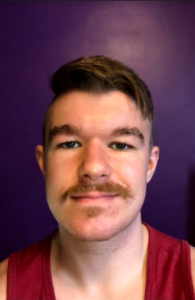March 30, 2021
 After beginning to write about my experiences as a queer man in sports, whether it be for my college newspaper or through popular LGBT social media outlets, I realized that the benefits between writer and audience are reciprocal. That is, talking about experiences can shed light on things for readers who might be struggling with mitigating their own identities and having a tough time with articulating feelings and features about the self, and this is incredibly rewarding to those fortunate enough to share their stories. Media outlets like Safe Space NOVA do the valuable work of showing readers numerous examples of LGBT+ folk who have been able to transcend their circumstances, so that LGBT+ youth can know that they have a happy and fulfilling future in store for them.
After beginning to write about my experiences as a queer man in sports, whether it be for my college newspaper or through popular LGBT social media outlets, I realized that the benefits between writer and audience are reciprocal. That is, talking about experiences can shed light on things for readers who might be struggling with mitigating their own identities and having a tough time with articulating feelings and features about the self, and this is incredibly rewarding to those fortunate enough to share their stories. Media outlets like Safe Space NOVA do the valuable work of showing readers numerous examples of LGBT+ folk who have been able to transcend their circumstances, so that LGBT+ youth can know that they have a happy and fulfilling future in store for them.
Besides providing examples of individuals successful in coming out and establishing happy relationships with gender and orientation, Safe Space NOVA helps provide clarity on the fuzzy and ambiguous subject that queerness can be. Growing up, I didn’t have any of that language, so when I began to question my identity it was a gray, scary process. Being a teenager in a religious school, being a questioning teen wasn’t always easy. Not only was I young, but I grew up in schools and spheres in which hostility to the LGBT+ community was all too common. Safe Space NOVA provides respite from the hostility and helps people articulate the strange and unwieldy subject that queerness often is.
Catholic schools vary in the rigidity and focuses of curriculum. For instance, some of my friends at other schools had to stay closeted for fear that they’d be asked to leave school if they were found out not to be straight. While this wasn’t an explicit worry of mine—I really didn’t feel with certainty of my queerness until college—any queer impulses of my own were met with frustration at being taught anti-gay doctrine in religion classes, and even more worrisome was paranoia at being outed and ostracized by my classmates, who used anti-gay slurs and gossiped about homosexuality all too often.
One would think that my reasonably accepting parents would offer an accepting refuge from the homophobia I skirted at school. After all, I have a cousin who’d been happily out for a few years by the time I began wrestling with identity. However, the problem with progress is that it comes only incrementally, and developments in cultural understanding and attitudes are often oversimplified, schematic, and compartmentalized. When it comes to gender identity and sexuality, this comes in heteronormative communities accepting queerness, but perhaps at first only on the binaries of male/female and straight/gay. When I began to have same-sex attraction, it didn’t come with a lapse in attraction to women. Lacking a working knowledge of bi- and pansexuality, the coexistence of attraction to multiple genders was incredibly confusing. When I eventually did come out to my family, that puzzlement extended to some of them, too. I’ve been out for several years now, and for the most part, this confusion is smoothed out, and I’ve had constructive conversations with intrigued family members. However, I’m almost 22. 15-year-old-Abram living queerly undercover and without exposure to the greater LGBT+ community was not prepared to have these conversations, and was not nearly in as safe a position to even fathom talking with classmates and friends about my sexuality.
My confusion and stress regarding my sexuality came with preexisting depression, and neither problem helped with the other. I coped with mental health problems not just with marijuana and self-harm in high school, but also with subscribing to many of the negative features of toxic masculinity. I didn’t go over the top with slurs and jokes, for instance, but I certainly tolerated them rather than taking a stand, whether for myself or for others. Plus, I was absolutely caught up in normative attitudes typical of high school kids acclimated with patriarchy. This is not a justification or an excuse, but an explanation. It’s incredibly easy and tempting to give in to societal norms as a means of suppressing undesirable and jarring facets of one’s own identity, and it is especially effective in maintaining an appearance such that nobody would suspect one’s queerness. Anywhere and anytime that people have the chance to talk about queerness and equality—and this needn’t be in complicated philosophical tomes—is a chance to undo these negative attitudes that allow toxicity and homophobia to persist. This is where groups such as Safe Space NOVA adopt the second of two immensely important roles. The first is that blog posts and articles allow LGBT+ youth to see that being out isn’t just survivable, but fulfilling. The second is that NOVA’s material engages with a movement in normalizing queerness so that queerphobia can be pushed to the brink of extinction, one paragraph and smiling face at a time.
